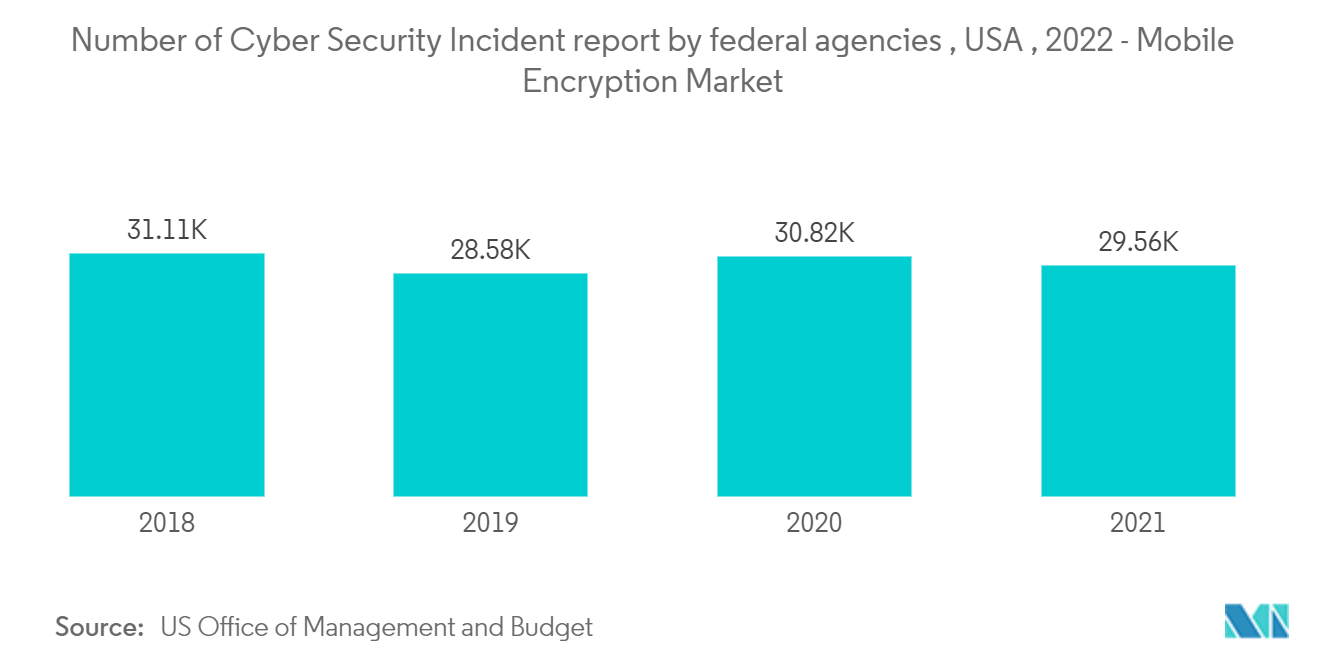Market Trends of Mobile Encryption Industry
BFSI is Expected to Hold a Major Market Share
- For the security of their mobile apps, banks employ a number of encryption techniques. For data in transit, common techniques include Transport Layer Security (TLS) and Secure Sockets Layer (SSL), whereas for data at rest, common techniques include Advanced Encryption Standard (AES) or RSA. To further safeguard customer information, banks may additionally employ extra security measures like multi-factor authentication and device fingerprinting. The banking industry's expanding requirement for payment security solutions to offer its consumers a more secure service is what is causing the growth.
- Among the current identified trends influencing this segment of the market, the usage of encrypted OTP SMS is one of them, along with a PIN to avoid any possible attacks like phishing, man-in-the-middle attacks, and malware Trojans. As more of the bank account information and passwords of customers come on mobile devices, even personal pictures (while applying for loans online) have become a major security concern. SSL/TLS enables secure transmissions of private data over the internet, including credit card details, passwords, and sensitive personal information.
- Banks and financial institutions use SSL/TLS to encrypt their traffic to address these multiple issues, including controlling access, protecting confidentiality, and reducing exposure to protocol-specific attacks. With the increased sophistication of online transactions, payment providers are catching up with the technologies to provide better security. The majority of online payments are now mobile or in-app payments; the traditional PCI-DSS standards have to be suitably upgraded.
- Moreover, it is projected that the efficiency and effectiveness of financial encryption software would grow with the addition of artificial intelligence (AI). At the same time, it helps organisations and customers meet the growing demand for data protection. As a result, it is anticipated that encryption software powered by artificial intelligence would be quickly adopted by the banking and finance sector.
- The integrity of the data must be maintained by the banks throughout the life of the data. As a result, it is essential for banks to put in place the appropriate threat detection and response procedures in accordance with their needs. Thus, by imposing various security standards, such as data masking and encryption software by banks, the data integrity can be preserved. As a result, it is anticipated that the banking, finance, and insurance (BFSI) industry will see an increase in demand for financial encryption software.
- The outdated SSL standards prevent the use of new initiatives like EMV Three-Domain Secure (3DS), a messaging mechanism that enables customers to authenticate themselves with their card issuer when making card-not-present online purchases.. Communication that uses two algorithms for encryption that work side-by-side is currently considered the strongest encryption, with cryptologists predicting double-cell encryption to remain so over the forecast period.

North America is Expected to Hold a Major Market Share
- In the North American region, the United States business sector increasingly depends on computer networks and electronic data to conduct its daily operations, and growing pools of personal and financial information are also transferred and stored in the cloud using phones. Furthermore, a significant increase in the BYOD trend is also favoring the conditions for advanced authentication methods, such as smart cards, physical tokens, and KPIs, to access sensitive information or log in to client servers.
- The dominance can be attributed to the more stringent regulatory standards in nations like Canada and the United States, which oblige banks to increase data privacy. In order to protect privacy, both public and private banks have increased their demand for cryptographic software. Additionally, the regional market expansion is anticipated to be fueled by the surge in cyberattacks and the threat to business-critical information.
- It is estimated that around 51% of mobile devices in the United States have full disk encryption, which is expected to increase in the coming years. However, with the growth in the adoption of full disk encryption, almost all these devices could become inaccessible to law enforcement. As a result, the government is regulating the encryption market. Companies like Google and other tech giants are facing restrictions and obstacles.
- AAG IT Services estimates that in 2021, 1 in 2 American internet users had their accounts breached. One in ten US businesses do not have any protection against cyberattacks. In addition, cybercrime had an impact on 53.35 million US individuals in the first half of 2022. Therefore, rising privacy laws and mobile payment technology are anticipated to open up new industry prospects in the area.
- Apple is the largest provider of mobile full-disk encryption, and around 55% of the mobile devices in the United States run on iOS. With increased malicious data breaches occurring in the North American region, it has become the largest market for encryption services.


